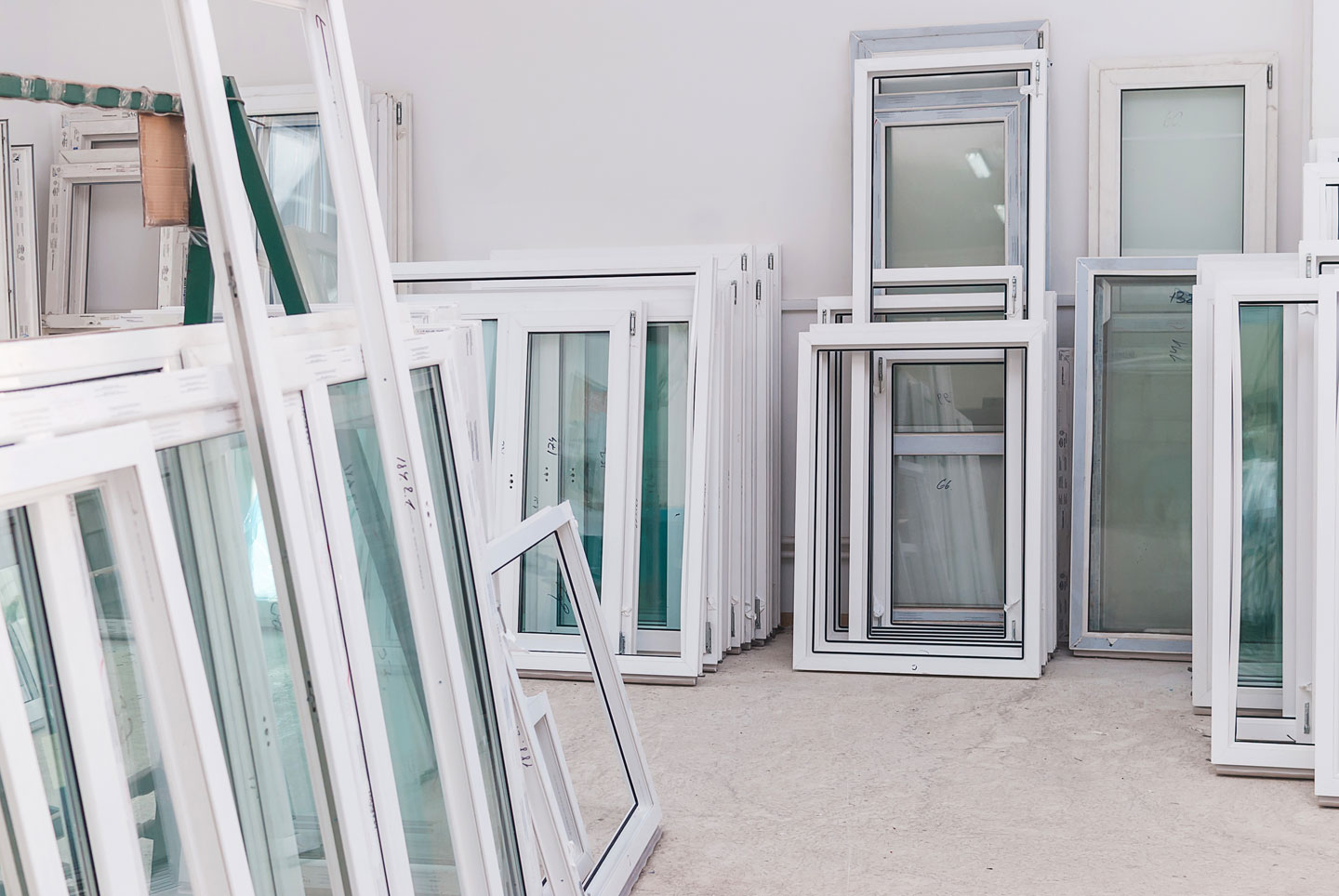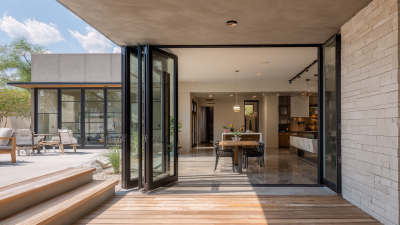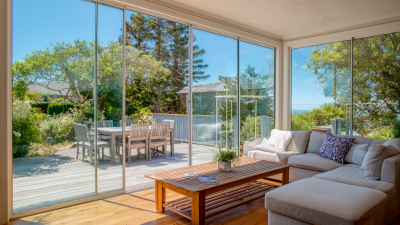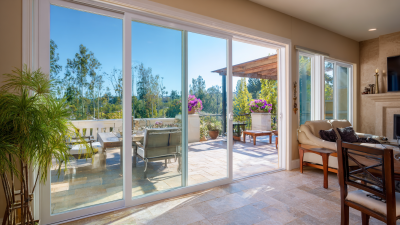
The Ultimate Guide to Patio Door Replacement Enhancing Outdoor Light and Energy Efficiency
 Patio door replacement is an essential home improvement project that not only enhances the aesthetic appeal of your living space but also significantly boosts energy efficiency and natural light in your home. According to the National Association of Realtors, replacing outdated patio doors can yield a return on investment of up to 70%, making it a financially sound decision for homeowners. Additionally, the U.S. Department of Energy states that energy-efficient patio doors can reduce heating and cooling costs by up to 15%, providing further financial benefits.
Patio door replacement is an essential home improvement project that not only enhances the aesthetic appeal of your living space but also significantly boosts energy efficiency and natural light in your home. According to the National Association of Realtors, replacing outdated patio doors can yield a return on investment of up to 70%, making it a financially sound decision for homeowners. Additionally, the U.S. Department of Energy states that energy-efficient patio doors can reduce heating and cooling costs by up to 15%, providing further financial benefits.
By opting for modern, high-quality patio doors, homeowners can enjoy improved insulation and a seamless transition between indoor and outdoor spaces, leading to a more comfortable living environment. This guide will delve into the key aspects of patio door replacement, offering tips and insights on how to select the right doors that align with your needs while maximizing light and energy efficiency.
Choosing the Right Patio Door Material for Energy Efficiency
When selecting a patio door, the material plays a pivotal role in enhancing energy efficiency. According to the Department of Energy, doors made from vinyl, fiberglass, or wood with high-performance glazing can significantly reduce heat transfer, leading to lower energy bills. For instance, a high-quality fiberglass door can offer an R-value of up to 5.0, which ensures minimal energy loss. This not only keeps your home comfortable year-round but also lessens the environmental impact by reducing reliance on heating and cooling systems.
Tips: When comparing materials, consider the climate of your area. In colder regions, insulated wood can provide excellent thermal performance, while vinyl may be more appropriate in warmer climates due to its ability to withstand heat without warping.
Additionally, opting for doors with Low-E (low emissivity) glass can further enhance energy efficiency. This special coating reflects infrared energy while allowing visible light to pass through, which can keep your home cooler in the summer and warmer in the winter. Reports from the National Renewable Energy Laboratory indicate that using Low-E glass can reduce energy costs by 7-15%, making it a worthwhile investment for long-term savings.
Tips: Always check for Energy Star labels and certification ratings when shopping for patio doors, as these indicators can help you identify products that meet stringent energy efficiency standards.

8 Key Features to Look for in Energy-Efficient Patio Doors
When considering patio door replacement, energy efficiency is a crucial factor that can significantly influence your home’s comfort and utility bills. Here are eight key features to look for in energy-efficient patio doors. First, ensure that the doors have a strong insulation rating. Look for doors with double or triple glazing which help reduce heat loss and improve overall thermal performance. Additionally, frames made from materials like fiberglass or low-conductivity vinyl can further enhance insulation.
Another critical feature is the type of glass used. Low-emissivity (Low-E) glass can reflect heat back into the home during winter and keep it out during summer, providing year-round comfort. Furthermore, consider the door's sealing mechanisms; high-quality weather stripping and multi-point locking systems will not only ensure a snug fit but also prevent drafts.
**Tips:** When choosing patio doors, always check for Energy Star certification, as this indicates compliance with energy efficiency standards. Also, don't overlook the importance of aesthetics; select a design that complements your home’s style while maximizing natural light. Lastly, invest in models that offer easy operability to enhance your outdoor experience without sacrificing energy efficiency.
The Ultimate Guide to Patio Door Replacement: Enhancing Outdoor Light and Energy Efficiency - 8 Key Features to Look for in Energy-Efficient Patio Doors
| Feature | Description | Benefits | Energy Efficiency Rating |
|---|---|---|---|
| Low-E Glass | Special glass that reflects infrared light while allowing visible light to pass | Reduces heat loss, keeps interiors comfortable | U-factor of 0.30 or lower |
| Increased Frame Insulation | Frames made from materials with high R-values | Enhances energy efficiency and durability | R-value of 5 or higher |
| Multi-Point Locking System | Locks at multiple points along the frame | Improves security and minimizes air leaks | N/A |
| Weatherstripping | Seals along the edges to prevent air and water leaks | Enhances insulation and energy efficiency | N/A |
| Dual-Pane or Triple-Pane Glass | Multiple layers of glass to improve insulation | Greatly reduces energy costs | U-factor as low as 0.20 |
| Solar Control Technology | Coatings that reduce solar heat gain | Keeps interiors cooler, lowers air conditioning costs | G-value of 0.25 or lower |
| FSC-Certified Wood | Doors made from sustainably sourced wood | Eco-friendly option, good insulation properties | N/A |
| Thermal Breaks | Insulating gaps within the frame material | Minimizes heat transfer | N/A |
Top 5 Styles of Patio Doors to Maximize Natural Light
When it comes to maximizing natural light in your home, choosing the right style of patio door can make all the difference. The top five styles include
sliding glass doors, French doors, bi-fold doors, pocket doors, and multi-slide doors. Each of these options offers distinct benefits that enhance both aesthetics and functionality. For instance, sliding glass doors provide an unobstructed view and are particularly effective for homes with limited space, while bi-fold doors create a seamless transition between inside and outside, opening up to breathtaking views and maximizing sunlight.
According to industry reports, homeowners who upgrade to energy-efficient patio doors can see a reduction in energy costs by up to 25%. This is particularly important as more people seek out ways to enhance energy efficiency in their homes. Additionally, large glass panels often used in these door styles can increase natural light by up to 40%, creating brighter, more inviting living spaces. As a result, selecting the right patio door not only improves your home's ambiance but can also contribute to sustainable living by reducing reliance on artificial lighting.

DIY vs. Professional Patio Door Replacement: Pros and Cons
When considering a patio door replacement, one of the first decisions to make is whether to tackle the project as a
DIY endeavor or hire a professional. Each option has its own set of advantages and disadvantages.
DIY enthusiasts might appreciate the cost savings and the ability to personalize the installation process to their
specific needs. However, it requires a fair amount of skill and time, and mistakes can lead to costly repairs down the line.
On the other hand, hiring a professional can ensure that the job is done correctly and efficiently, often resulting
in a superior finish and potentially better energy efficiency. Professionals bring their expertise to the table,
which can be especially beneficial in terms of ensuring proper installation and adherence to local building codes.
However, this option usually entails a higher upfront cost.
Tips for Patio Door Replacement:
- Consider measuring the door frame accurately or seeking professional advice to avoid common sizing errors.
- Don’t hesitate to ask about energy-efficient models—they can save money on heating and cooling in the long run.
- Whether going DIY or professional, take the time to research local regulations and permits required for patio door installations.
Maintaining Your New Patio Door for Optimal Performance and Longevity
Maintaining your new patio door is crucial for ensuring optimal performance and longevity. Regular upkeep not only preserves aesthetics but also enhances energy efficiency. According to the National Fenestration Rating Council (NFRC), well-maintained doors can reduce energy loss by up to 30%, translating to significant savings on heating and cooling costs. To keep your door functioning at its best, it is essential to inspect seals, tracks, and hinges periodically to avoid drafts and ensure smooth operation.
- Clean and Lubricate: Regularly clean the tracks and apply a silicone-based lubricant to the rollers and hinges to prevent rust and ensure smooth movement.
- Check Weather Stripping: Inspect and replace weather stripping as needed to maintain energy efficiency and reduce air leaks.
- Inspect Glass: Regularly check for cracks or condensation between glass layers. If any issues are detected, consider professional repair or replacement to avoid energy waste.
By following these simple maintenance tips, you can extend the lifespan of your patio door while keeping your home comfortable and energy-efficient.
Related Posts
-

Reliable Chinese Manufacturing of the Best Patio Doors for Global Buyers
-

Exploring Best Patio Doors: Features, Usability, and Tips for Global Buyers
-

Common Challenges Faced When Selecting Best Patio Doors for Global Buyers
-

8 Reasons Why Best Sliding Glass Patio Doors Enhance Home Value by 30 Percent
-

Global Leaders in Patio Door Replacement Manufacturing Driving Exports to Meet Global Demand
-

Innovative Single Hung Replacement Windows Trends at the 138th Canton Fair 2025

